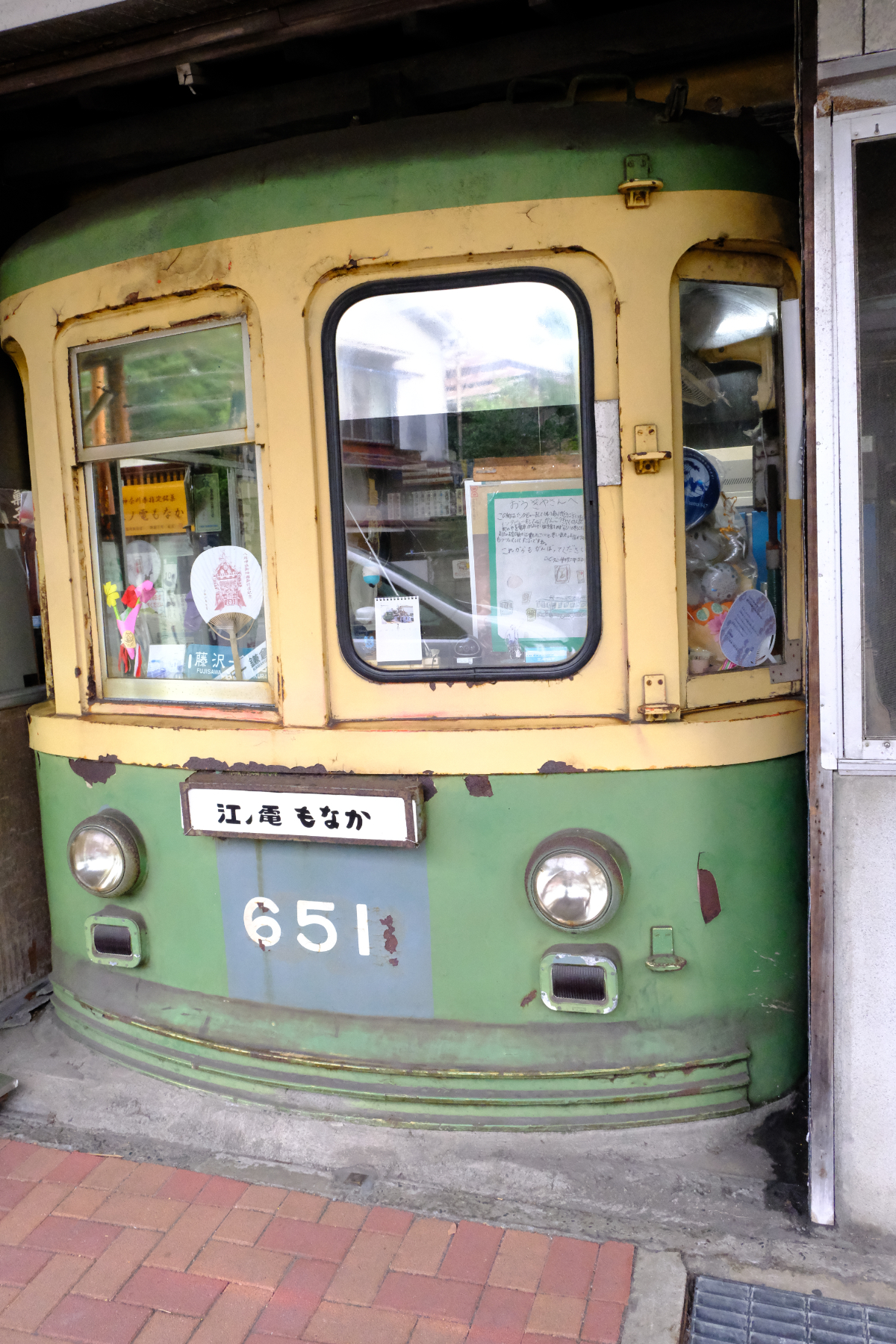江ノ島電鉄
【いざ、梅雨の江の島へ】
7月、梅雨も明けきらぬ曇天の中、ふらっと江の島方面へと足を向けた。
大船からモノレールに乗り込み、終点まで乗り通す。
湘南江の島駅に到着すると、駅構内は以前に比べずいぶんと新しくモダンに整備されていた。
駅には、かわいらしいプラレールの展示があり、江ノ電も走っている。
【江ノ電自転車ニキ】
湘南江の島駅からすぐ近くに位置するここは、あの伝説的な自転車ニキで世間に知れ渡った、江ノ島~腰越の併用軌道上のカーブである。
自転車ニキとは、2021年8月5日の夜、点検と塗装を終えて試運転をする江ノ電300形電車305編成を撮影すべく集まっていた撮り鉄集団の前に、突如自転車に乗って現れた白人男性である。
その存在は、湘南の生ける伝説として人々の心に深く刻まれている。

305編成が偶然にもやってきた。
そのまま腰越電車通り商店街を歩き、鎌倉高校前駅方面へと向かう。
腰越の台所、Fresh Store YAOMINEの前には、こんなガチャガチャが立っていた。
販売元は江の島ともだち幼稚園とある。
幼稚園がこういったものを販売するのは珍しいように思う。
【電チラ探しつつ海のほうへ】
腰越を過ぎると、電車は住宅や寺社のスキマを縫うように走る。

路地裏に目を向ければ、ひょっこりと電車が顔を出すこの感じがまさしく電チラ。江ノ電らしさとはこういうところだ。

視界が急に開け、湘南の海が広がる。
あいにくの曇り空だが、上の写真と反対側には江の島と、晴れた日には富士山が望める。
【鎌倉高校前の現状とオーバーツーリズム】
鎌倉高校前駅が近づくにつれて、人通りが一段と増えてくる。中国人観光客が多いようだ。
数年前から、鎌倉高校前は漫画「スラムダンク」の影響で多くの観光客でごった返している。
地元住民の生活を脅かしているという話も耳にする。
湘南の海を右手に眺めつつ、思考を巡らせていると鎌倉高校前駅が見えてきた。
駅すぐ横の鎌倉高校前1号踏切は、噂に違わず観光客だらけだ。
しかし、普段から通勤通学で駅を利用している人にとっては悪影響だ。こういうのをオーバーツーリズムというらしい。
何事も、他人に迷惑のかからない範囲でやりましょう。
【喉が渇いたな】

ふと、気が付けばもう午後三時だ。
今日は昼飯も食べそびれてしまったのだった。
鎌倉高校前駅を後にして、腰越商店街に戻ってみるか。
曇り空といえど、今日は充分に暑い。この乾いたのどを癒してくれる、昼から飲れる店を探すのだ。
見つけたのが鎌倉波平という看板。
生しらす丼やおでんが楽しめるお店だ。
それに、電車通りに面しているので、店の真ん前を江ノ電が走る最高のトレインビュースポットだ。
【トレインビューで飲ろうぜ】
暖簾をくぐるとお客は僕だけのようだ。まずはビール。
一番センター赤星がうれしい。
オーダーは、波平定食、税込み2,750円。
男一人の遅い昼飯、たまには贅沢したっていいじゃないか。
今日の大将おすすめはマゴチの刺身。スーパーではまずお目にかかれない夏の高級魚だ。身がプリッとしていて実にうまい。
おっ、このアオリイカもねっとり甘くておいしい。
生しらすも久しぶりに食べたけど、やっぱりうまいね。ビールがすすむすすむ。
そんな具合に、生しらすをビールで飲りつつ、鎌倉高校前駅周辺の惨状について思いを巡らせてみる。
【中国人はマナーが悪い?】
確かに、今日は道の真ん中に立ち止まったり、人の家の門扉の中にカメラを差し込んで撮影したり、立入禁止の場所に無遠慮に足を踏み入れる中国人観光客の姿を目にした。
ここで断わっておかねばならないのだが、僕は決して差別主義者等ではない。
井上ひさし氏の「握手」に登場するルロイ修道士の言葉、「日本人とかカナダ人とか、アメリカ人といったようなものがあると信じてはならない。一人一人の人間がいる、ただそれだけのことである。」を胸に抱き、生きている。
それに、大学時代の恩師の一人である呉先生は中国人で、大変高潔な人格者であり、僕が通うスナックのママもまた哈爾浜出身であるが、とてもいい人である。
「スラムダンク」は世界中で人気だし、観光客は何も中国人ばかりではない。韓国人や欧米人も訪れているはずなのに、なぜ中国人観光客が日本で嫌われてしまうのだろうか。
まず第一に、中国語という言語の特性によるところだ。
中国語は四声といって、同じ発音でも音調の違いで意味が異なる。
例えば、「妈」(mā:お母さん)、「麻」(má:麻)、「马」(mǎ:馬)、「骂」(mà:叱る)。
これらは日本語で表記すればすべて「ま」なのだが、中国語では音調がなければ意味が通じない。
そのため、中国語を話すときは、声をはっきりと大きく発する必要がある。
中国人同士が会話しているのを聞いて、喧嘩をしているのかと思ったらただの世間話だった、というのはこのためである。
第二に、文化の違いだ。
中国人が飲食店でテーブルを汚すのは、中国では食事中に出る骨や殻などのゴミはテーブルの上に置くのが一般的だからである。
それに中国ではどこでもたばこを吸い、ごみを持ち帰る習慣がないので吸殻はポイ捨てするのが一般的だ。
日本とは真逆の慣習に加え、性格も違う。中国人は簡単には謝らない。
日本人にとって「すみません」は社会的潤滑油であるが、中国人にとって謝罪とは責任の認識であるため、非常に慎重に行われる。謝罪よりもむしろ交渉や和解の方法を探すことが一般的だ。
反対に中国人から見れば、すぐに謝る日本人は責任の所在をあいまいにする、信用ならない奴らと思うかもしれない。
第三に、国家としての背景だ。
日本人にとって、ヘゲモニー政党制による事実上の一党独裁体制は異質なものに感じ、どこか得体の知れない国というイメージを生んでいる。
また、内政への干渉や影響力行使に対する警戒感を持っている日本人も多いことだろう。その根底には、戦争による歴史的な対立の記憶や、今もなお存在する尖閣諸島などの領土問題が深く関係しているに違いない。
しかし、日中両国ともに若い世代ほど、お互いの印象は良くなる傾向にあるようだ。未来の世代に期待したいところである。
【ごちそうさまでした】
さて、そんなことを考えていたら酒がなくなった。大瓶もう一本行っちゃおうかな。
たまに店の軒先を通過する江ノ電のジョイント音が心地よい。
大瓶二本と定食を平らげて、腹もいっぱい。そろそろ帰ろうか。
ほろ酔いの足取りで自転車ニキのカーブに帰ってきて、しばしやって来る電車を眺める。

お土産に扇屋さんの江ノ電もなかと腰越ガチャ。
さて、次は何処で飲ろうか。旅は続く。